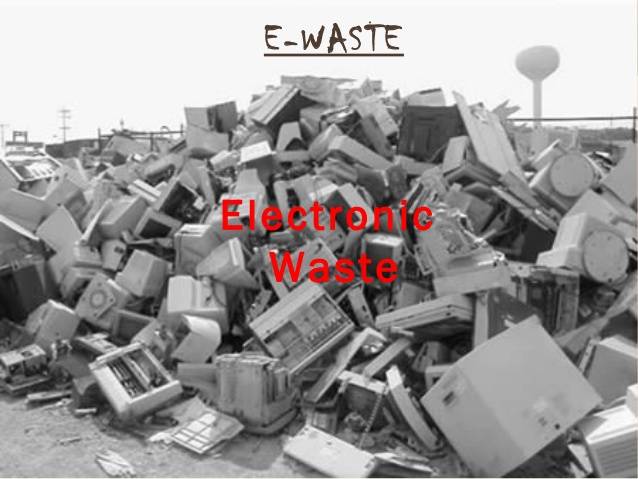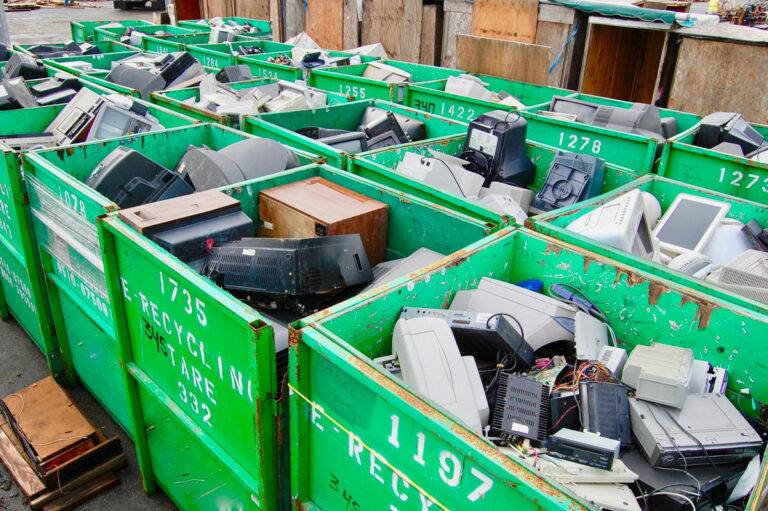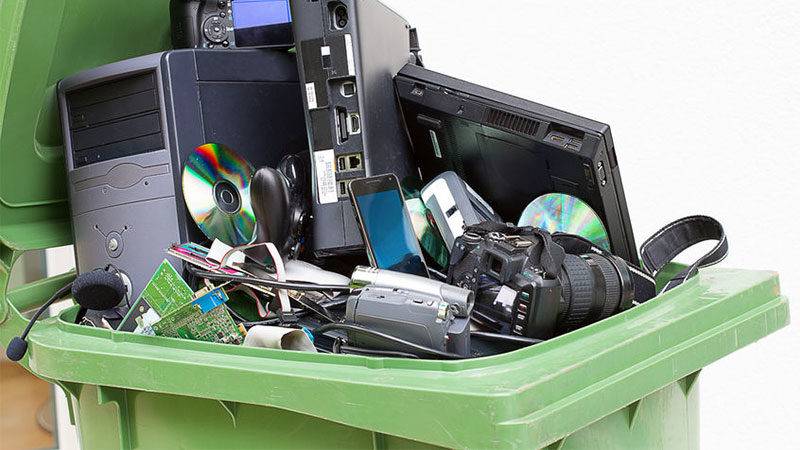1. Electronic Waste : How Big of a Problem is it?
Electronic Waste (e-waste) is one of the fastest-growing segments of our nation’s waste stream. It encompasses all broken, unusable, or outdated/obsolete electronic devices, components, and materials. In addition, e-waste also encompasses items that can be e-cycled (electronics that are going to be reused, resold, salvaged, or recycled).
This makes sense as our technology growth rate continues to accelerate exponentially. As previously mentioned, technology seems to become all but obsolete only a short time after it’s purchased. That quick turn over usually happens in our periphery because, with electronics, out of sight really is out of mind.
Here are some basic examples of common electronics that quickly evolved and turned previous versions into electronic waste.
How many of the items below have you discarded in your lifetime:
– Cell phones
– Smartphones
– PDAs
– Pagers
– Computer monitors
– Computers/CPUs
– Laptop computers
– Photocopiers
– Printers
– Scanners
– Fax machines
– Stereos
– Radios
– MP3 players (or iPods)
– Landline telephones
– DVDs
– Televisions (Tube, plasma, and LCD, LED)
– VCRs
– Cameras
– CD players
– Video game consoles
Here is a list of some of the more recent electronic items that will most likely render their predecessors useless. You may have the newest versions of the following, but think back to the older models that have been discarded:
– All smart devices (iPhones, iPads, iWatches, Fitbits, Kindles, Nooks, Amazon Fire Tablet, etc.)
– Virtual Reality (VR) gear
– Virtual Assistants (Amazon Echo, Google Home, etc.)
– Electric scooters
– Portable speakers
– Security cameras
– Roombas
– Professional and personal drones
– Projectors
– Modems and routers
– GPS Devices
– Smart bathroom scales
– Some thermostats
The effects of e-waste
Reduce, Reuse, and Recycle are terms that most people commonly associate with items such as paper, plastic, and glass. The need to recycle these items is understood because of the global impact that they can have when their only purpose is to take up space in a landfill. But what about e-waste?
E-waste can be some of the most dangerous discarded items but they are rarely seen as such. Why is that? The reason often comes down to their packaging.
There is definitely a false sense of security when it comes to our electronics being non-hazardous when they become waste. Part of the problem is the packaging of the devices. Their sleek and appealing exteriors make it hard to see them as waste. When you look at a landfill image of stacks of old TVs and laptops, for instance, you only see the benign exterior. It’s what you can’t see that makes electronic waste so dangerous.
According to facts presented by the Electronics Takeback Coalition “Electronic scrap components, such as CPUs, contain potentially harmful components such as lead, cadmium, beryllium, or brominated flame retardants.” Additional components such as mercury and arsenic can also be present. All elements listed can have a severe human impact through exposure.
If these items aren’t handled correctly they can cause organ damage, neurological damage, and severe illness not only in the workers that handle them directly but also within the communities of the developing countries where they are shipped.
The threat comes from exposure during recycling and disposal efforts. The harmful components listed above can leak into the ground as they are packed into landfills. They can also be released when the items are incinerated, a common method for disposal.
*NOTE: The United States, and other economically established countries, handle some e-waste recycling but the EPA estimates that 25% of recyclable electronic waste is shipped away.
How does e-waste affect the environment?
At this time the effects of improper e-waste disposal are not well known, however, the effects that are known have a very real global impact on the earth’s air, water, and soil.
The air pollution impact of e-waste:
Burning e-waste can be used as a disposal method but can also be a way to get to valuable metals such as copper. The problem with this method is that burning can also release pollutants into the air. For instance – when computer monitors and other electronics are burned, they create cancer-producing dioxins that are then released into the air. Yes… that’s the same air that we breathe.
The impact of e-waste on water:
Remember those contaminants we mentioned before? Some of those are heavy metals – Lead, barium, mercury and also lithium (found in mobile phone and computer batteries). When these heavy metals are improperly handled or disposed of via landfill, they can leak into the soil and eventually the groundwater. Picture the groundwater as the first domino waiting to fall. The heavy metals then make their way from the groundwater into streams then ponds, lakes, and rivers. These heavy metals make the water tables toxic and unusable for the communities, animals, and plants that rely on them.
The impact of e-waste on soil:
Though the soil is the pathway on which heavy metals find water, it does not go unaffected by these harmful contaminants. E-waste has a very negative impact on the Soil-Crop-Food Pathway. The Soil-Crop-Food Pathway is exactly as it sounds – crops grow in the soil and food comes from the crops. When the soil is contaminated by heavy metals via e-waste the crops, and the food they provide, are also contaminated. This causes many of the illnesses mentioned above and restricts viable farmland for clean food production.
Article source: rubiconglobal.com
2. 5 Common Myths About Electronic waste Recycling
 Go into any office nowadays, and you’re bound to see electronic devices —from computers and cell phones to copy machines and networking equipment—being used for all sorts of day-to-day activities.
Go into any office nowadays, and you’re bound to see electronic devices —from computers and cell phones to copy machines and networking equipment—being used for all sorts of day-to-day activities.
But once those electronics become obsolete and need to be disposed of, you would be surprised to find out where a lot of those old electronics end up. Oftentimes, because of rapid advances in technology and planned obsolescence, old electronics just end up piled up in a storage room or warehouse—or, worse, in a landfill (many times overseas).
Regulations are in place to prevent the illegal dumping of used electronic equipment. But as any smart businessperson knows, e-waste recycling ultimately comes down to taking responsibility for your own organization’s actions and making sure that all e-waste is disposed of properly.
In the past, when e-waste was still a novel concept, it might have been easier to get caught up in some of the myths about e-waste recycling. But with proven methods in place that make electronic waste recycling more manageable for consumers and businesses, there is no reason why our society’s zero waste goals can’t be achieved in this generation.
Here is a closer look at some of these misconceptions and the truth behind them.
Myth: It’s impossible to avoid the landfill.
Fact: Recycling technology has advanced way more than what we think, so it is possible to recycle much more today.
Also, not all e-waste has to end up in landfills. Take, for example, what we’ve done at Surplus Service. One of our clients has over 400 global locations and needed a better solution for managing all the e-waste generated in its many offices. The client didn’t have a streamlined process for handling the disposal of electronics, so it was becoming a huge problem.
Using our UpcyclIT® system, which makes use of upcycling—a reuse alternative to recycling destruction—we were able to successfully divert 100% of that company’s e-waste from the landfill.
Myth: Only old TVs and computers can be recycled.
Fact: You can recycle computers, monitors, cell phones, servers, switches, test equipment, lab equipment, medical imaging equipment, fiber optics, networking devices and more.
A good rule of thumb is to check with a website like CalRecycle.CA.gov or RecycleWhere.org to find a certified e-recycler that can dispose of all types of electronics in accordance with the Electronic Waste Recycling Act of 2003.
Myth: It’s better to Recycle and Shred E-Waste than go through the process of refurbishing and reusing it.
Fact: When you’re done with a piece of electronic equipment, you don’t have to necessarily shred it or have it broken down. Many electronic devices—from servers to CT scanners—can still be refurbished, repaired and reused even though they might have been deemed obsolete.
In fact, there are many small companies in the U.S. and overseas in the secondary market that would greatly benefit from a larger organization’s surplus electronics.
Having a good asset management plan will also ensure that there is no data breach for your organization and the refurbished electronics meet the established standards of the industry.
Myth: There is nothing you can do to prevent e-waste from being exported overseas to countries with weak environmental regulations.
Fact: You can control how your organization handles e-waste. With the right policies and education of personnel, your e-waste doesn’t have to be exported at all.
By incorporating zero waste reporting into your e-waste recycling procedures, you can even track exactly where your used electronics go when they leave your facility so there will be no doubt that your organization’s reputation can be maintained.
Myth: Getting rid of e-waste is a hassle.
Fact: E-waste disposal is actually pretty simple, provided you have the right knowledge and a reliable partner. There are simple steps that each organization—large or small—can take to make sure that you’re doing your part to meet your sustainability goals and reduce your liability.
According to the International Association of Information Technology Asset Managers, “smart ITAD programs can further save companies money and gain tax benefits by depreciating and amortizing their older assets over time.”
In all, e-waste disposal is not just about recycling. It’s also about keeping up with environmental regulations and helping your business’s bottom line, which should be a win-win for everyone.
Article source: surplusservice.com
3. What is Environmental Liability?
 Environmental Liability is the potential environmental cost that a consumer acquires when purchasing a product or service. Being aware of your environmental liability as a business is not only ethically responsible but fiscally responsible. Environmental disasters can hurt your reputation and with the EPA’s newly created National Enforcement Initiatives (NEI's), it can lead to massive fines and other financial punishment.
Environmental Liability is the potential environmental cost that a consumer acquires when purchasing a product or service. Being aware of your environmental liability as a business is not only ethically responsible but fiscally responsible. Environmental disasters can hurt your reputation and with the EPA’s newly created National Enforcement Initiatives (NEI's), it can lead to massive fines and other financial punishment.
Businesses should consider their impact on the environment, even if they don’t fall into the traditional industries associated with air pollution and chemical spills—and ways to minimize environmental liability. Considering how prominent technology plays in the modern business world the specter of electronic waste, or e-waste rears its ugly head as a primary form of environmental liability for a business.
E-Waste as Environmental Liability
Public perception associates most episodes of environmental liability with smokestacks pumping air pollutants or toxic chemicals in our waterways, but e-waste is just as problematic. A business may have dozens of computers, monitors, printers, batteries, phones and the list goes on and on. The big picture is that businesses require, purchase and maintain a large amount of electronic equipment and this equipment is constantly being upgraded and replaced. This replaced equipment is usually thrown away, forming e-waste.
E-waste has a long list of environmentally damaging elements such as:
- Toxins
- Mercury
- Lead
- Nickel
- Barium
- Zinc
- Chromium
- Flame retardants
- And more
Once the waste makes it to the landfill and is exposed to heat and other elements, the toxic chemicals can seep into the soil, bleed into our water systems, and permeate throughout the atmosphere. These toxic elements can affect humans and animals alike, causing many health issues that can affect organs and blood cells.
With e-waste reaching 50 million metric tons annually, this makes it a formidable form of environmental liability and with the forward march of technology happening at a rapid pace, electronic waste is only going to increase. This makes e-waste something all modern businesses should take into consideration.
Here are some striking e-waste stats that demonstrate there’s a lot of work to be done when it comes to recycling:
- 2 percent of America’s total trash found in landfills is E-waste, even though it accounts for 70 percent of the total toxic waste
- Cell phones contain high quantities of precious metals like gold or silver.
- Only 12.5 percent of e-waste is recycled properly
If businesses start focusing on recycling more electronic waste, these negative numbers can decrease; and the number of precious metals in the circular economy will increase.
Tackling Your Environmental Liability
Since many of the components found in e-waste are laced with these hazardous materials, it becomes a necessity for businesses to recycle their trove of old electronics. More importantly, many businesses are required to recycle their electronics. When companies evade regulations and requirements for managing their surplus of e-waste, they could incur legal consequences.
With the impact of social consciousness and the growing trend for boycotting businesses that do not take their part in the managing of the earth’s vital resources; businesses can’t afford to lose out on customer’s due to poor policies on recycling.
In recent years, there’s been a growth in consumer protests linked to environmental activism. With social media making it easier to organize, companies should be aware of the importance of their steadfastness to environmental issues. A new rise in activism has also created an insurgence of employee-based boycotts on companies, which makes it even more important to take a look inwards and push a more forward-thinking agenda when it comes to tackling environmental liabilities.
It’s important to note that e-waste as an environmental liability can be taken care of relatively easily. There’s no reason why a business should find it so difficult to dispose of electronic waste. The resources are all at a business’ fingertips for eliminating this liability.
Old technology might have exceeded its use in the office but it still has value and uses beyond it. Manufacturers purchase e-waste in an effort to minimize manufacturing cost because it’s cheaper than making a whole new product.
Article source: ewaste1.com


